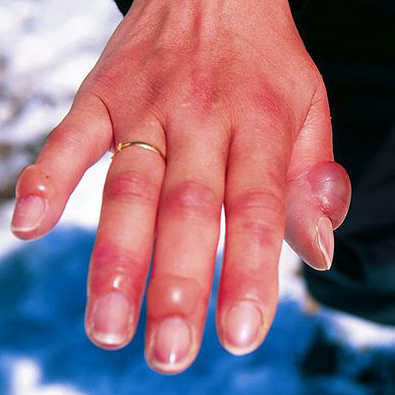WHAT WE TREAT
Frostbite
Frostbite leads to tissue injury due to exposure to very cold temperatures.
This condition often leads to tissue damage, and some serious cases may lead to amputation.
In fact, 65% of patients suffer long-term symptoms due to their frostbite – particularly if untreated, such as pain, abnormal sensations in the affected area, heat or cold sensitivity, excessive sweating, and arthritis.
While this condition can occur anywhere, it is most common in Alaska, Canada, and the northern states, as these locations have extremely cold temperatures in the winter months.

What is Frostbite?
Frostbite is a condition that causes the skin to harden and become discolored, due to the constriction of blood vessels in the extremities from prolonged exposure to below-freezing temperatures. Patients with frostbite should be assessed and treated immediately, to avoid risk of severe damage or need for amputation. Cell death from frostbite occurs at the time of exposure to freezing temperatures, with further deterioration occurring as time passes, causing additional cell death from the lack of oxygen.
During frostbite, body tissues can actually freeze, forming ice crystals in the cells. This may lead to permanent damage or changes in cell chemistry or makeup. Further, once the ice crystals melt, additional damage can occur, many times resulting in cell death. Frostbite may also lead to blood clots in small blood vessels, producing cell damage.
There are increasing levels of severity of frostbite. Frostnip, which is the first stage of frostbite, is a mild condition and can be treated at home with rewarming techniques. Frostnip may also be referred to as first-degree frostbite. Superficial frostbite only affects the surface of the skin, and skin can easily recover with prompt and effective treatment. Deep frostbite affects the skin as well as the underlying cells and tissues. Second, third, and fourth-degree frostbite all involve frostbite beneath the epidermis. Second-degree frostbite affects the epidermis and part of the dermis. Third-degree frostbite affects the epidermis, dermis, and fatty tissue beneath. Fourth-degree frostbite affects all three layers of skin, the tissues below the skin, and deeper structures including the muscles, tendons, and bones. Frostbite that affects blood vessels causes permanent damage.
The extremities and other body parts that are farther from your core are more likely to be affected by frostbite, due to decreased blood flow. Such areas include the fingers, hands, toes, feet, nose, and ears. This is because when you are in a cold environment, your body’s first priority is to maintain its core, or optimal, temperature. The body does this by shifting the blood flow away from the extremities and towards your central, vital, organs. Body parts that have less blood flow are more likely to become injured and prone to frostbite.
Frostbite can occur in as little as a few minutes, especially if exposed to extreme cold, below freezing temperatures, and strong winds. This condition may also arise in environments that are above freezing, but have strong gusts of wind.
Complications from frostbite, especially if left untreated, include growth defects in children, infection, tetanus, gangrene (decay and death of tissue), long-term numbness or permanent loss of sensation in the affected area, changes in the cartilage between joints near the affected area (frostbite arthritis), and hypothermia (decreased body temperature). Hypothermia can lead to respiratory failure, heart failure, and even death.
What Causes Frostbite?
Frostbite is caused when a person is exposed to extremely cold temperatures (below 5 degrees F, -15C) and is not adequately covered or warmed. This condition can also occur in above-freezing temperatures with extreme wind. In a wind chill of negative 16.6 degrees F (-27 degrees C), frostbite can occur in less than 30 minutes. Patients who stay out in the cold too long, and those who get wet while in freezing temperatures often get frostbite. Frostbite can also occur simply by direct contact with ice, freezing metals, or extremely cold liquids.
Anyone is susceptible to frostbite, and this condition can occur when people are not sufficiently protected when exposed to extremely cold environments. Several populations of patients are at increased risk of suffering from frostbite. Such groups of people include:
-
Patients with diabetes (these patients often already have decreased circulatory problems)
-
People who spend a lot of time outdoors
-
Those who are under the influence of alcohol
-
The elderly
-
Young children
-
Soldiers
-
The homeless
-
People who are excessively dehydrated
-
Patients who are mentally ill
-
Patients who suffer from Raynaud’s phenomenon (a condition where cold temperatures or strong emotions cause blood vessel spasms)
-
People who have poor blood supply or other circulatory issues (such as peripheral vascular disease)
-
Patients who have had a previous cold-related injury
-
Patients who have atherosclerosis
-
Patients who are taking medications such as beta blockers, as these drugs reduce blood flow to the skin
-
People who use nicotine
-
Patients who are at a high altitude
-
Those who are experiencing fear and panic, which may inhibit your ability to respond in the cold
Signs and Symptoms of Frostbite
Patients with frostbite often experience a numbness, burning, tingling, itching, or very cold sensation in the affected areas. Symptoms first start out as redness, stinging, and burning, leading to a throbbing and prickling sensation and eventually numbness. The skin may also appear waxy, white, or grayish.
Frostbite may also cause clumsiness, due to stiffness developing in the joints and muscles.
More severe frostbite results in decreased sensation, leading to overall loss of sensation. Severe frostbite may also cause gangrene (blackened, dead tissue), blisters, and further damage to tendons, muscles, nerves, and bone. The skin may appear pale, yellowish, bluish, or mottled. In severe cases, the skin is black.
In superficial frostbite, deeper tissues may still feel soft while the skin is frozen. In deep frostbite, the entire affected extremity or body part will feel solid, hard, and frozen.
Prevention of Frostbite
Frostbite is completely preventable if you take care to protect yourself. Working outdoors, playing outdoor winter sports, or simply walking around outside in cold weather can increase your risk of getting frostbite. The single most effective way to prevent worsening of possible frostbite is to go inside, and get away from extreme cold.
When in a cold environment and especially during the winter months, it is important to always take care to cover exposed skin. Helpful methods of prevention include:
-
Wearing light and loose clothing in layers – try to wear clothing that provides ventilation and insulation, and add a top layer that is water-repellant
-
Wear mittens (which are warmer than gloves), two pairs of socks (wool is better than cotton), and a hat (one that covers your head and ears is best)
-
Avoid getting wet
-
If wet, seek a dry and warm area and remove wet clothing
-
Avoid drinking alcohol or smoking if you know you are going to be outside in the extreme cold
-
Stay hydrated – dehydration increases your risk of frostbite, so try to drink water prior to going outside
-
Increase physical activity when in a cold environment to maintain body warmth and prevent onset of frostbite, but not to a degree of exhaustion
Another useful method to avoid worsening of frostbite is to check your body every 30 minutes for signs of possible frostbite when outside in a cold environment. Being aware and proactive in avoiding frostbite can significantly improve the outcome of such a condition.
Treatment of Frostbite
It is very important to treat frostbite as soon as possible. Frostnip can be treated with at-home techniques, however other severities of frostbite should be evaluated and treated by a medical professional, to lessen the risk of possible infection or nerve damage.
If available, try to go inside a warm room, away from the cold. Remove any jewelry and wet or constrictive clothing. Rest, keep the affected body part elevated to reduce swelling, and take ibuprofen to ease inflammation. Drinking a warm drink, such as tea or broth, can also help to begin rewarming the body. Pain can be managed with over-the-counter treatment such as ibuprofen (Advil, Motrin IB).
During the rewarming process, the affected body part may swell and change color, this is normal. You may also notice the formation of blisters. To prevent infection, do not attempt to cut them away. Loosely cover blisters with a sterile or clean cloth, separate fingers and toes with a cloth, and seek further medical assistance.
When treating frostbite, try to avoid doing something that may increase injury to the affected body part. This includes:
-
Avoid walking on feet that are frostbitten
-
Refraining from massaging or rubbing the affected area
-
Avoid using dry heat, such as heat from a heating pad, fire, blow dryer, or radiator – the affected skin is numb and is at high risk for burning easily
-
If there is a chance that you will be exposed to extreme cold again, without protection, avoid attempting to warm the affected body part – freezing, warming, and then refreezing skin is susceptible to severe tissue damage
-
Avoid drinking alcohol and smoking while treating frostbite, as these substances can interfere with blood circulation
Medical treatment involves rapid rewarming, often in a warm water bath, followed by removal of any dead tissue. The affected body part will be immersed in warm – not hot – water for 15-45 minutes, until the affected area regains sensation and feels warm. The recommended water temperature is between 99-108 degrees F (37.2-38.3 degrees C). Your local physician may also prescribe narcotics to help manage pain often associated with the rewarming process. If an infection arises, you may also be prescribed antibiotics. To help restore blood flow, a medical professional may administer an intravenous thrombolytic, such as a tissue plasminogen activator (TPA). A doctor may also remove damaged tissue. This process (debridement), helps the frostbitten area to heal effectively. In severe cases, surgery may be warranted, often for amputation of dead tissue.
Patients being treated for frostbite should also be evaluated for possible hypothermia and dehydration.
Your doctor may suggest whirlpool therapy, or hydrotherapy, which involves soaking in a whirlpool bath. This can help to treat frostbite by keeping skin cleansed and clean, while also naturally removing dead tissue through the movement of the water. Another treatment technique that has been helpful in treating some patients with frostbite is hyperbaric oxygen therapy, which involves breathing in pure oxygen in a controlled and pressurized room.
When Should I Call a Doctor?
Frostbite should be dealt with immediately, so seek medical care as soon as you suspect that you are suffering from frostbite. Early intervention can help reduce the chance of further complications or more severe damage. While amputation or skin grafting may be consequences of severe frostbite, it typically takes a 1-3 months to determine the full extent of such damage, to determine which tissues are still viable and which tissues have died, so such drastic measures will not be done immediately after experiencing frostbite.
Consult a medical professional especially if you develop new symptoms in addition to frostbite, such as fever, nausea, discoloration of the skin, or drainage of the affected area.
Emergency Warning Signs
If you do not begin to feel sensation in the affected area after attempting treatment, or if your skin begins to turn grey or black, seek emergency medical care immediately.
Other signs that emergency medical help is needed include intense shivering, slurred speech, drowsiness, and loss of coordination.
If this is a medical emergency, please call 911. For mental health emergencies, call 988.
Have a visit today
Virtual care is a convenient and secure way to receive medical care for frostbite by phone (where permitted) or video, 24/7/365.
